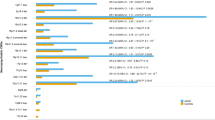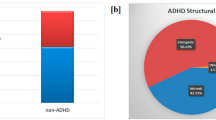Abstract
Molecular genetic studies in attention deficit hyperactivity disorder (ADHD) have focussed on candidate genes within the dopamine system, which is thought to be the main site of action of stimulant drugs, the primary pharmacological treatment of the disorder.1 Of particular interest are findings with the dopamine transporter gene (DAT1), since stimulant drugs interact directly with the transporter protein.2,3 To date, there have been eight published association studies of ADHD with a 480 base-pair allele of a variable number tandem repeat (VNTR) polymorphism in the 3′-untranslated region of the gene, five4–8 that support an association and three9–11 against. We have analysed the same VNTR marker in a dataset of UK Caucasian children and an independent dataset of Turkish Caucasian children with DSM-IV ADHD, using the transmission disequilibrium test (TDT).12 Results from the UK (χ2 = 8.97, P = 0.001, OR = 1.95), but not the Turkish sample (χ2 = 0.93, P = 0.34) support association and linkage between genetic variation at the DAT1 locus and ADHD. When considered alongside evidence from other published reports, there is only modest evidence for the association, consistent with a very small main effect for the 480-bp allele (χ2 = 3.45, P = 0.06, OR = 1.15), however we find significant evidence of heterogeneity between the combined dataset (χ2 = 22.64, df = 8, P = 0.004).
This is a preview of subscription content, access via your institution
Access options
Subscribe to this journal
Receive 12 print issues and online access
$259.00 per year
only $21.58 per issue
Buy this article
- Purchase on Springer Link
- Instant access to full article PDF
Prices may be subject to local taxes which are calculated during checkout
Similar content being viewed by others
References
Collier DA, Curran S, Asherson P . Mission: not impossible? Candidate gene studies in child psychiatric disorders Mol Psychiatry 2000 5: 457–460
Swanson JM, McBurnett K, Christian DI, Wigal T . Stimulant medications and the treatment of children with ADHD. In: Ollendick TH, Prinz RJ (eds) Advances in Clinical Child Psychology, vol 17 Plenum Press: New York 1995 265–322
Volkow N, Ding YS, Fowler J, Wang GJ, Logan J, Gatley SJ et al. Is methylphenidate like cocaine? Arch Gen Psychiatry 1995 52: 456–463
Cook EH et al. Association of attention deficit disorder and the dopamine transporter gene Am J Hum Genet 1995 56: 993–998
Waldman ID, Rowe DC, Abramowitz A, Kozel ST, Mohr JH, Sherman SL et al. Association of the dopamine transporter (DAT1) and attention deficit disorder in children: heterogeneity owing to diagnostic subtype and severity Am J Hum Genet 1998 63: 1767–1776
Gill M, Daly G, Heron S, Hawi Z, Fitzgerald M . Confirmation of association between attention deficit hyperactivity disorder and a dopamine transporter polymorphism Mol Psychiatry 1997 2: 311–313
Daly G, Hawi Z, Fitzgerald M, Gill M . Mapping susceptibility loci in attention deficit hyperactivity disorder: preferential transmission of parental alleles at DAT1, DBH and DRD5 to affected children Mol Psychiatry 1999 4: 192–196
Barr CL, Xu C, Kroft J, Feng Y, Wigg KG, Zai G et al. Haplotype study of three polymorphisms at the dopamine transporter locus confirm linkage to attention deficit hyperactivity disorder Biol Psychiatry 2001 4: 333–339
Swanson JM, Flodman P, Kennedy J, Spence AM, Moyzis R, Schuck S et al. Dopamine genes and ADHD Neurosci Biobehav Rev 2000 24: 21–25
Holmes J, Payton A, Barrett JH, Hever T, Fitzpatrick H, Trumper AL et al. A family-based and case-control association study of the dopamine D4 receptor gene and dopamine transporter gene in attention deficit hyperactivity disorder Mol Psychiatry 2000 5: 523–530
Palmer CG, Bailey JN, Ramsey C, Cantwell D, Sinsheimer JS, Del'Homme M et al. No evidence of linkage or linkage disequilibrium between DAT1 and attention deficit hyperactivity disorder in a large sample Psychiatr Genet 1999 9: 157–160
Spielman RS, McGinnis RE, Ewens WJ . Transmission test for linkage disequilibrium Am J Hum Genet 1993 52: 506–516
Alexander M, Sadovnick AD, Remick RA, Keck PE, McEleroy S, Kelsoe JR . Identification of SNPs within the dopamine transporter gene reveals a segmental linkage disequilibrium structure Neuropsychiatr Genet 2000 96: 564
Giros B, Jaber M, Jones SR, Wightman RM, Caron MG . Hyperlocomotion and indifference to cocaine and amphetamine in mice lacking the dopamine transporter Nature 1996 379: 606–612
Gainetdinov RR, Wetsel WC, Jones SR, Levin ED, Jaber M et al. Role of serotonin in the paradoxical calming effect of psychostimulants on hyperactivity Science 1999 283: 397–401
Gainetdinov RR, Caron MG . An animal model of attention deficit hyperactivity disorder Mol Med Today 2000 6: 43–44
Weizman A, Bernhout E, Weitz R, Tyano S, Rehavi M . Imipramine binding to platelets of children with attention deficit disorder with hyperactivity Biol Psychiatry 1998 23: 491–496
Lou HC, Henriksen L, Bruhn P, Borner H, Nielsen JB . Striatal dysfunction in attention deficit and hyperkinetic disorder Arch Neurol 1989 46: 48–52
Castellanos FX . Toward a pathophysiology of attention deficit hyperactivity disorder Clin Pediatr 1997 36: 381–393
Dougherty DD, Bonab AA, Spencer TJ, Rauch SL, Madras BK, Fischman AJ . Dopamine transporter density in patients with attention deficit hyperactivity disorder Lancet 1999 354: 2132–2133
Krause K, Dresel SH, Krause J, Kung HF, Tatsch K . Increased striatal dopamine transporter in adult patients with attention deficit hyperactivity disorder: effects of methylphenidate as measured by single photon emission computed tomography Neurosci Lett 2000 285: 107–110
Heinz A, Goldman D, Douglas MD, Jones DW, Palmour R, Hommer D et al. Genotype influences in vivo dopamine transporter availability in human striatum Neuropsychopharmacology 2000 22: 133–136
Mill J, Curran S, Kent L, Richards S, Gould A, Virdee A et al. Attention deficit hyperactivity disorder (ADHD) and the dopamine D4 receptor gene: evidence of association but no linkage in a UK sample Mol Psychiatry 2001 6: 440–444
Tahir E, Yazgan Y, Cirakoglu B, Ozbay F, Waldman I, Asherson PJ . Association and linkage of DRD4 and DRD5 with attention deficit hyperactivity disorder (ADHD) in a sample of Turkish children Mol Psychiatry 2000 5: 396–404
Angold A, Costello E . A test-retest reliability study of child-reported psychiatric symptoms and diagnoses using the Child and Adolescent Psychiatric Assessment (CAPA-C) Psychol Med 1995 25: 755–762
Conners CK . The Conners Rating Scales: Instruments for the Assessments of Childhood Psychopathology Duke University 1995
Curran S, Newman S, Taylor E, Asherson P . Hypescheme: an operational criteria checklist and minimum data set for molecular genetic studies of attention deficit and hyperactivity disorders Am J Med Genet 2000 96: 244–250
Kaufman J, Birmaher B, Brent D et al. Schedule for affective disorders and schizophrenia for school-age children—present and lifetime version (K-SADS-PL): initial reliability and validity data J Am Acad Child Adolesc Psychiatry 1997 36: 980–988
Achenbach TM . Manual for the Child Behaviour Checklist Department of Psychiatry, University of Vermont: Burlington
Curtis D, Sham PC . Population stratifications can cause false positive linkage results if founders are untyped Ann Hum Genet 1996 60: 261–263
Acknowledgements
This research was funded by a Medical Research Council (MRC) component grant to the Social Genetic Developmental Psychiatry Research Centre. The Turkish sample was collected with funds from TUBITAK, and the Eczacibasi Scientific Research Award. Control samples were collected with funds from a Wellcome Training Fellowship to SC, and UB samples were collected with funds from a Wellcome Training Fellowship to LK. JM is an MRC PhD student. Mike Gill provided data used in original publications from the Irish group for re-analysis. We wish to thank all clinicians and families who helped in this research. Particular thanks go to Dr Geoff Kewley, Dr Mark Berelowitz, Professor Peter Hill, Fiona McNicholas, Mary Cameron and Saama El Abd.
Author information
Authors and Affiliations
Corresponding author
Rights and permissions
About this article
Cite this article
Curran, S., Mill, J., Tahir, E. et al. Association study of a dopamine transporter polymorphism and attention deficit hyperactivity disorder in UK and Turkish samples. Mol Psychiatry 6, 425–428 (2001). https://doi.org/10.1038/sj.mp.4000914
Received:
Revised:
Accepted:
Published:
Issue Date:
DOI: https://doi.org/10.1038/sj.mp.4000914
Keywords
This article is cited by
-
Association study and a systematic meta-analysis of the VNTR polymorphism in the 3′-UTR of dopamine transporter gene and attention-deficit hyperactivity disorder
Journal of Neural Transmission (2019)
-
Stuttering candidate genes DRD2 but not SLC6A3 is associated with developmental dyslexia in Chinese population
Behavioral and Brain Functions (2014)
-
The association between dopamine receptor (DRD4) gene polymorphisms and second language learning style and behavioral variability in undergraduate students in Turkey
Molecular Biology Reports (2014)
-
Association study between the dopamine-related candidate gene polymorphisms and ADHD among Saudi Arabia population via PCR technique
Molecular Biology Reports (2012)
-
Dopamine Transporter (SLC6A3) Genotype Impacts Neurophysiological Correlates of Cognitive Response Control in an Adult Sample of Patients with ADHD
Neuropsychopharmacology (2010)



